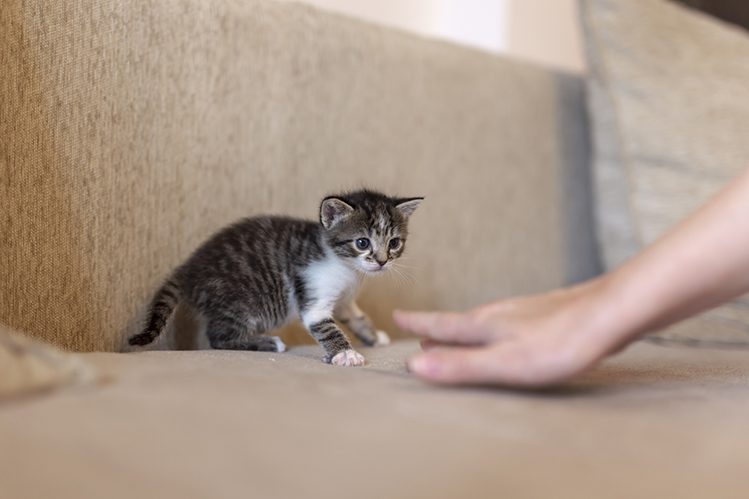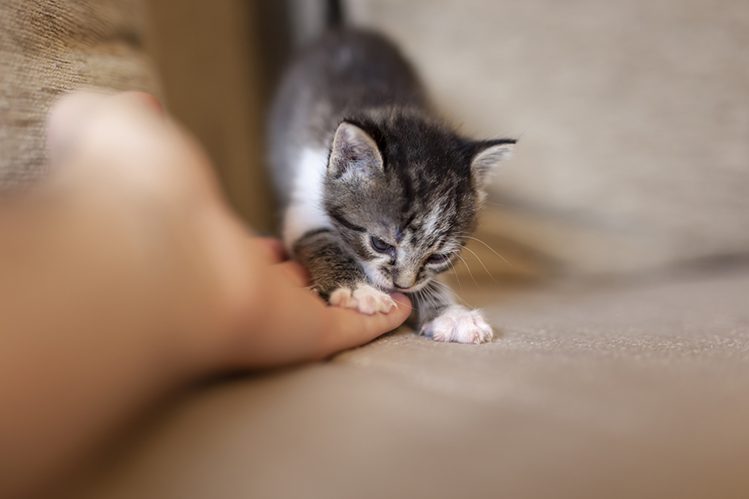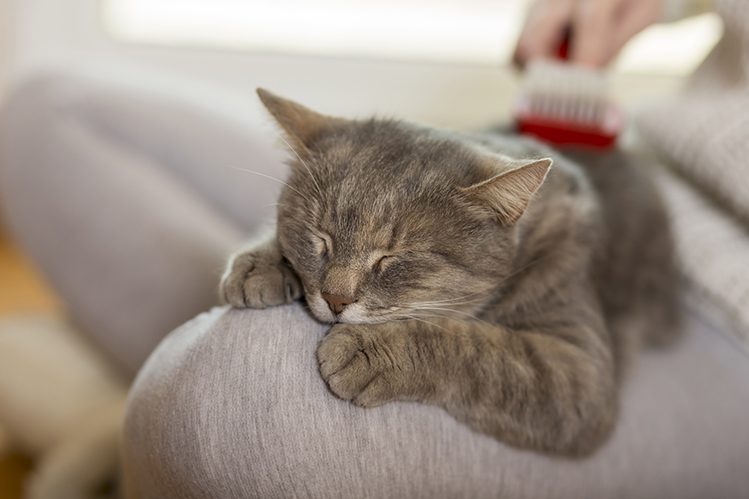
How to tame a cat?
Each cat is an individual. Some of them love affection as much as dogs. Others keep their distance and allow themselves to be stroked only on holidays. And then there are wild, unsocialized (or insufficiently socialized) cats that were taken from a shelter or picked up on the street. How to find an approach to them? How to tame a cat or kitten? Read our article.
The Egyptians domesticated cats 5-6 thousand years ago. And even before the Egyptians, this was done by the inhabitants of Turkey and Crete. We will no longer know when and by whom exactly the first cat in history was tamed, but this process began at least 10 years ago.
And what prevents us from repeating the feat of our ancestors? That’s right: nothing. Unlike the Egyptians, we have everything we need for this: tons of information in books and the Internet, animal psychologists, toys and healthy treats that will help win the heart of a domestic hunter. The main thing is to be patient.
The process of domesticating a cat can take a couple of weeks, or maybe several months. It just won’t, but as a result you will get a true, loving friend. Are you ready for the challenge? Then let’s go!
A kitten is easier to tame than an adult cat. His natural childish curiosity will help you. No matter how cautious the kitten is, curiosity will eventually overcome fear. The kid will quickly adapt to new conditions, learn to communicate with family members and feel at home. You only need to create a safe environment for him and give him some time to adapt.
Kittens need no more than two weeks to get used to a new place and owners. But if the baby had a negative experience of communicating with people, it will take more time.

- Your main helpers are patience, toys and healthy treats. Do not try to immediately take the kitten in your arms. First you need to earn his trust and make sure that he comes to you for affection.
Set up a hiding place for the kitten: it can be a special house for cats or a box with bedding. Don’t forget to put a bowl of water next to it!
Make it a rule not to disturb the kitten while he is resting in his shelter. Let the kitten “sit out” in the house. Having calmed down, he will definitely go to study the world around him.
To get started, just be in the same room with the kitten, talk to him calmly, offer him treats, and involve him in the game. It is rare for a kitten to resist a teaser or a ball.
If the baby makes contact, great. If not, no big deal, leave it alone and try again next time.
The rules for taming a kitten are generally the same as for an adult cat.
- Step 1. Prepare the room
Prepare your home for your pet. Install protection on windows and doors, remove dangerous objects from the floor and shelves, insulate cables and sockets.
The cat will need its own house: it can be a simple box with bedding, a bed or a special house for cats. It is best to purchase a pet cage. You can put a house, and bowls, and a tray in it. The cage helps a lot in the first stages of education and in the future. In it, the pet is always safe.
A cat will feel safer more quickly if the light in the room is dimmed and if it is quiet. Try to create the most comfortable and calm atmosphere.
- Step 2. Give time to adapt
How long does it take for a cat to adjust? It all depends on the individual cat. Sometimes it only takes a few hours, sometimes a few days or weeks.
Let the cat rest in peace in his shelter. Do not pull her out of the house, do not try to pick her up. The first 3-4 hours it is better not to disturb the cat at all. Leave her alone with herself. Do not forget to put a bowl of water and a tray in the room.
After 3-4 hours, offer the cat to eat. It’s great if she immediately comes to the bowl and starts eating in your presence. But if the cat is afraid, leave the room for a while so that she eats alone.
Do not look the cat directly in the eye, do not try to “look over” it. This will turn the pet against you.
- Step 3Restrict Contacts
A new home is stressful for a pet. Even more stress is forced communication with strangers and animals.
If possible, protect the cat from contact with other family members. First, she must get used to the new environment and one person – the owner.

- Step 4. Communicate but don’t touch
Gradually spend more and more time around your cat. Don’t touch her if she’s not ready for it. Just go about your business and at the same time calmly talk to the cat. And yes, you don’t have to talk. Work on the computer or read a book so the cat can see you. Your task is to accustom her to your society, to show that you do not threaten her with anything.
Try not to make noise or make sudden movements so as not to scare the pet.
- Step 5. Play and trust
When the cat gets used to the new environment a little, try to involve it in the game. Get a special teaser with fluffy feathers, a ball or toys with catnip – it’s hard to resist them.
If the cat starts playing right away, great. If not, postpone the venture for a while. Try again in a couple of days.
At the taming stage, we recommend wearing long-sleeved clothes to protect yourself from possible scratches.
- Step 6. Delicious treat
A super effective cat training assistant is a treat. The main thing is that it be useful: during this difficult period, stomach problems will be very inopportune. Therefore, it is better to purchase special balanced treats for cats.
Give your cat a treat in the palm of your hand. Our goal is for her to come up behind him and feast on him. Usually cats take a long time to decide on this step, then quickly grab a treat and run away. For starters, this is also very good! But to prolong contact with your pet and quickly accustom him to you, you can go for a trick and use liquid treats (such as liquid Mnyams cream treats). Cats like liquid treats much more than dry treats (remember how pets like to lick jelly off liquid food?). Your beauty will have to linger to lick more treats from your hand and you will get more contact.
While the cat eats from your hand, calmly watch it. Talk to her softly. Don’t rush to pet her.

- Step 7. Introduce the hand
We are gradually starting the main part of our domestication. Now our task is to introduce the cat to the handles. And again, the main thing is not to rush!
Do not reach out to the cat, do not try to stroke it. Just place your hand palm down next to the cat. Give her the opportunity to come to your hand, sniff it, rub it. If the cat does not fit, you can put a treat on your hand. Did not work? No problem. Try again in a couple of days.
- Step 8: Iron properly
Only after the cat learns to approach your hand without fear, you can finally try to stroke it!
Pay close attention to your cat’s reaction. If she recoils and hisses, leave her alone and go back to the previous points. Communicate with the cat from a distance for several days, and then try again.
Be patient: no pressure! Otherwise, all the work will go down the drain.
- Step 9. Pick up the right way
Does the cat allow himself to be petted? Excellent. Then you can proceed to the next step and try to pick her up. To do this, gently turn the cat with its back to you and lift it in this position, put it on your knees, stroke it. If the cat breaks out, do not hold it by force. Please try again later.
- Step 10. Accustom to combing
The next step is to accustom the cat to combing. Combing is not just hair and skin care, but also a pleasant contact with the owner.
It is important to choose a tool that is right for your cat and will make the procedure comfortable. It can be a comb-mittens, a furminator, a slicker brush or a comb.
- Step 11: Ask for help
If several days have passed, and the cat is still very shy and there is no improvement in her behavior, contact a zoopsychologist. It will help you find the right approach to your pet.
Injured animals can be very afraid of people, and without the help of a specialist they cannot cope.

We hope that our recommendations will help you tame a cat and find in her person the most faithful, devoted and grateful friend. And we thank you in advance for your patience and work, for your love for animals. Your pet is very lucky to have you!





